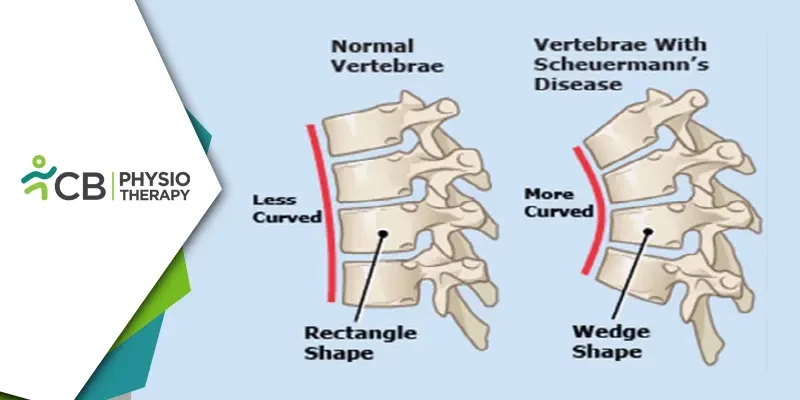Scheuermann's Disease, also known as Scheuermann's Kyphosis, is a condition that primarily affects adolescents and results in a forward rounding of the upper back. Named after the Danish radiologist Holger Scheuermann who first described the condition in 1921, it is considered one of the most common causes of structural kyphosis during adolescence. This blog delves into the nature of Scheuermann's Disease and explores how physiotherapy can play a vital role in managing the condition.
What is Scheuermann's Disease?
Scheuermann's Disease is a growth disorder of the vertebrae, where the bones of the spine grow unevenly, with the front growing slower than the back. This uneven growth leads to a wedge-shaped deformity of the vertebrae, which causes the spine to bend forward abnormally. The condition typically affects the thoracic (upper back) region but can also occur in the lumbar (lower back) region.The exact cause of Scheuermann's Disease is still unknown, though it is believed to be multifactorial, involving genetic, mechanical, and possibly endocrine factors. It tends to occur more frequently in boys than girls, with symptoms often appearing between the ages of 10 and 15.
The most noticeable symptom of Scheuermann's Disease is an abnormal curvature of the spine, typically resulting in a rounded, hunchback appearance. This kyphosis is usually rigid, meaning the spine cannot be straightened fully by posture correction alone. Other symptoms can include particularly in the area of the curvature. Pain often worsens with activity or prolonged standing or sitting. Individuals may experience stiffness in the back and a reduced range of motion, particularly in the thoracic spine. Due to the abnormal posture, muscles in the back can become fatigued more quickly, leading to overall tiredness.
In severe cases, where the curvature is extreme, the disease can lead to respiratory and cardiovascular issues due to the compression of the chest cavity.
Treatment Options for Scheuermann's Disease
The treatment approach for Scheuermann's Disease depends on the severity of the condition and the symptoms experienced by the patient. Treatment options range from observation and conservative management to surgical intervention in extreme cases.
Role of Physiotherapy in Managing Scheuermann's Disease
Physiotherapy is a cornerstone in the conservative management of Scheuermann's Disease. The primary goals of physiotherapy are to reduce pain, improve posture, enhance spinal flexibility, and strengthen the muscles supporting the spine. Below are the key components of a physiotherapy program for Scheuermann's Disease:1: Postural Education and Correction
A key focus of physiotherapy for Scheuermann's Disease is teaching patients about proper posture and maintaining it. Although the kyphosis in Scheuermann's Disease is structural and cannot be fully corrected by posture alone, improving postural awareness can help reduce pain and prevent further progression of the curvature. Physiotherapists educate patients on how to align their spine correctly and practice good posture during daily activities.
2: Stretching Exercises
Stretching exercises are designed to increase flexibility in the muscles and ligaments surrounding the spine, particularly in the thoracic region. These exercises target tight muscles, such as the pectorals (chest muscles) and hamstrings, which can contribute to the abnormal posture seen in Scheuermann's Disease. Regular stretching helps to alleviate stiffness and improve the range of motion in the spine.
Common stretches may include:
a: Chest stretches: To open up the chest and counteract the forward pull caused by tight pectoral muscles.
b: Hamstring stretches: To alleviate tightness in the back of the thighs, which can contribute to poor posture.
c: Thoracic extension exercises: To promote the extension of the thoracic spine, counteracting the forward curvature.
3: Strengthening Exercises
Strengthening exercises are crucial in stabilizing the spine and improving the overall posture. These exercises focus on strengthening the muscles that support the spine, including the core muscles, back extensors, and scapular stabilizers. A strong core provides better support for the spine, reducing the load on the vertebrae and potentially slowing the progression of the curvature.
Examples of strengthening exercises include:
a: Core stabilization exercises: Such as planks and bridges, which strengthen the abdominal and back muscles.
b: Back extension exercises: To strengthen the muscles along the spine, particularly the erector spinae.
c: Scapular retraction exercises: To strengthen the muscles between the shoulder blades, helping to correct rounded shoulders and improve posture.
4: Manual Therapy
Manual therapy techniques, including joint mobilizations and soft tissue massage, can be beneficial in managing Scheuermann's Disease. Joint mobilizations help to improve the mobility of the spine, particularly in areas where movement is restricted due to the kyphosis. Soft tissue massage can alleviate muscle tension, reduce pain, and improve circulation in the affected areas.
5: Breathing Exercises
In cases where Scheuermann's Disease affects the thoracic region severely, it can impact lung function by compressing the chest cavity. Breathing exercises can be incorporated into physiotherapy to enhance lung capacity and improve respiratory function. These exercises focus on diaphragmatic breathing and expanding the rib cage, promoting better oxygen intake and reducing the risk of respiratory complications.
6: Bracing and Orthotics
In certain cases, particularly in younger patients with a more significant curvature, bracing may be recommended in conjunction with physiotherapy. The brace helps to halt the progression of the curvature by maintaining the spine in a more neutral position. While wearing the brace, physiotherapy exercises continue to be essential to strengthen the muscles and improve posture.
Scheuermann's Disease is a challenging condition, particularly for adolescents who are already navigating the complexities of growing up. However, with the right approach, including a comprehensive physiotherapy program, many of the symptoms can be managed effectively. Physiotherapy not only addresses the physical aspects of the condition but also empowers patients with the knowledge and skills to maintain a better quality of life.

